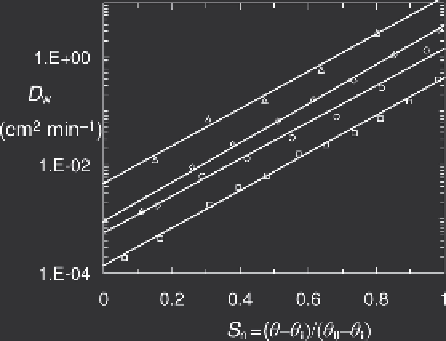Geoscience Reference
In-Depth Information
Fig. 8.30 Soil water diffusivity
D
w
(cm
2
min
−
1
) as a function of normalized water content
S
n
=
θ
0
− θ
i
) during horizontal infiltration (see Equation (9.25) and Figure 9.2)
into uniform air-dry soil columns. The points are the experimental values and they represent
Fresno fine sand (triangles), Hanford sandy loam (diamonds), Yolo clay loam (circles), and
Sacramento clay (squares); the straight lines are the exponential approximations by means of
Equation (8.39) with the parameters
θ
0
,θ
i
,β
and
D
wi
, respectively, equal to 0.31, 0.007, 7.97,
and 0.004 58 for Fresno, 0.35, 0.012, 8.36, and 0.000 90 for Hanford, 0.42, 0.04, 7.85, and 0.000 56
for Yolo, and 0.55, 0.07, 8.02, and 0.000 14 for Sacramento. (Data from Reichardt
et al
., 1972.)
(
θ − θ
i
)
/
(
(8.32), to wit
D
w
=
k
0
α
S
e
1
−
S
e
γ
(8.41)
where
α
=
[(
θ
0
-
θ
r
)
ab
]
−
1
,
β
=
(
n
−
b
−
1
−
1),
γ
=
(
b
−
1
−
1) and
δ
=
1 in the case of
(8.15), or
α
=
[(
θ
0
−
θ
r
)
abc
]
−
1
,β
=
[
n
−
(
bc
)
−
1
−
1]
,γ
=
(
b
−
1
−
1) and
δ
=
c
−
1
in the
case of Equation (8.16).
8.3.5
Some models for permeability
The experimental determination of the hydraulic conductivity is never easy for saturated
soils, but it is especially difficult for unsaturated soils as a function of soil water content.
For this reason, many attempts have been made to develop simple conceptualizations of the
flow process and to represent
k
=
k
(
θ
) by simple parametric equations, in terms of other
properties of the soil that are easier to determine.
Uniform pore size models
In one common approach the porous medium is assumed to be analogous to a bundle of
uniform and parallel capillary tubes with circular cross section. Around 1950, Averyanov
(Polubarinova-Kochina, 1952) analyzed the flow of an annulus of wetting fluid in a single
tube, the central part of which was occupied by stagnant air. The solution of this flow
problem yielded an equation that could be approximated closely by (8.36) with a power
n
=
3.5. By making the slightly different assumption that the non-wetting fluid at the center
of the tube moves under the same pressure gradient as the wetting fluid along the wall,
Yuster (1951) obtained Equation (8.36) with
n
=
2. In a different approach, use is made

